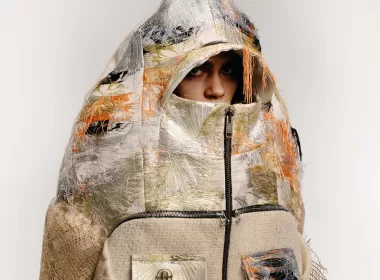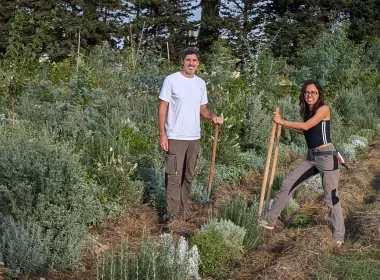An Amazonian encounter with preeminent sustainable-agroforestry expert Ernst Götsch in 2007 inspired a couple of then-journalists, Dayana Andrade and Felipe Pasini, to dramatically change careers. Götsch’s principles of planting in harmony with natural succession influenced the couple’s subsequent dedication to implementing syntropic agriculture in Mediterranean ecosystems in 2018, and they have been working in southern Italy, Portugal, and Spain ever since. In their latest project, an Italian farm named Amadeco, four distinct designs have been in operation since 2021 and model how this interdisciplinary approach to organizing plants “not only horizontally and vertically but also throughout time, according to their life cycles” successfully produces food while healing the environment.
Syntropic farming maintains balance by matching species’ light needs, shade tolerance, and growth stages to each environmental context. The approach optimizes photosynthesis, root exudation, and soil health, all of which combine to provide consistent nourishment for soil organisms, protect against erosion, and build resilience against pests and diseases. Andrade and Pasini explain, “We’re focused on addressing local challenges like degraded soils, saline water, not to mention the phytosanitary crisis that has devastated olive groves throughout the region. Amadeco farm is an experiment in finding solutions for these issues. We hope that our efforts will serve as one example of how to recover and regenerate the Mediterranean ecosystem in all its exuberance.”
The couple have come to see farming as “blending science, ecology, and ethics.” The smallest design at Amadeco is a syntropic “garden” that has aesthetic purposes experienced via walking paths and features a high diversity of vegetables, fruits, aromatics, and timber. The garden has proved to be not only sensorily pleasing but also resilient in terms of water management, demonstrating its suitability for areas with water restrictions, whether rural or urban. The larger designs are partly based on the land’s existing olive groves planted at traditional distances, between which three other species such as figs and pecans have been added for each olive tree. This design reconciled the planting density of intensive monocultures – systems that grow a single crop for economic efficiency – with the ecological functions inherent to a syntropic system. Andrade points out, “This is not all! In the strips between the tree lines and the olive hedgerow, we are carrying out tests of no-till grain production,” a method that avoids soil disruption from ploughing to preserve structure and fertility. The four distinct designs at Amadeco give the farm the flexibility and autonomy to adapt to local realities without relying on external technological packages.
According to this innovative farming couple, the key to their success has been the relentless pursuit of knowledge. They offer workshops to extend the benefits of their work, noting, “Encouragingly, we’ve seen a growing movement, especially among young people in southern Italy, eager to be part of this shift.” They encourage anyone interested in syntropic farming to “take the time to explore the latest scientific discoveries and dedicate yourself to extensive practice, whether on a farm, a small garden, or even a vase.”
What inspired you both to transition from journalism to practicing and promoting syntropic farming?
Felipe & Dayana – Our journey began in 2007 when we first met Ernst Götsch. His ideas sparked a deep curiosity in us as journalists, but it quickly became more than just a story to tell. We were drawn to test his theory ourselves—to grow food while healing ecosystems. It wasn’t just about reporting; we saw an opportunity to be part of the solution. The more we engaged, the more questions we could ask (and better questions), turning it into a virtuous cycle that became our obsession and life’s mission.
How did your collaboration with Ernst Götsch begin, and what has been the most significant lesson you’ve learned from him?
Felipe & Dayana – Our collaboration with Ernst began when we worked on agroforestry projects in the Brazilian Amazon, where he was a consultant and we handled audiovisual documentation for a bioactive cosmetics company. Over time, Ernst became comfortable with how we captured and communicated his work, leading to the creation of Agenda Götsch in 2011—the first platform to freely share syntropic agriculture content (also known as successional agroforestry). His most valuable lesson was interpreting natural dynamics through cooperation, syntropy, and unconditional love. His interdisciplinary approach transformed how we see farming, blending science, ecology, and ethics.
Our partnership grew, with key milestones like launching Life in Syntropy at COP21 [the 2015 United Nations Climate Change Conference] and co-running a syntropic farming school that reached over 800 students. Working closely with Ernst has enriched our understanding of the profound interconnection between farming, ecosystems, and human responsibility.
How do you implement the principles of syntropic farming on your farm regarding plant diversity and ecological succession?
Felipe & Dayana – At Amadeco Farm, we use syntropic farming’s principles of ecological succession and stratification to guide plant selection and distribution. This means we organize plants not only horizontally and vertically but also throughout time, according to their life cycles. This approach optimizes photosynthesis, root exudation, and soil health, providing consistent nourishment for soil organisms, protecting against erosion, and building resilience against pests and diseases.
The layering of plants, from ground cover to canopy, balances transpiration, enhancing biotic regulation of local climate and rainfall, as outlined by the Biotic Pump Theory. This strategic plant distribution—denser at lower levels and sparser above—helps create an autonomous, regenerative system that continuously improves the land. Matching species’ light needs, shade tolerance, and growth stages to each environmental context are key to maintaining this balance.
On larger scales, the benefits extend further, supporting sustainable food production while contributing to broader climate regulation, proving that syntropic designs offer long-term ecological and agricultural stability. At Amadeco, we implemented four distinct designs that follow these principles, giving us the autonomy to adapt to local realities without relying on external technological packages. This experience has truly demonstrated the potential for syntropic farming to restore ecosystems while producing nutrient-dense food.
How were your four plots conceptualized and what specific goals you have for each?
Felipe & Dayana – Amadeco is a 9-hectare farm that had already some divisions made with beautiful stone walls that are very typical of the southern Italian region. These stones, in fact, are a testimony to the agricultural work of long generations – each time the soil was worked, the stones were collected and used to build these divisions. We took advantage of this cultural and historical heritage to define the limits of our areas. At the same time as honoring the local agricultural tradition, we dared to bring a new agricultural proposal that, unlike the historical use of that land, works with high biodiversity systems and focuses on the regeneration of the soil fertility and the ecosystem dynamics.
Since the autumn of 2021, we’ve been working on 4 areas at Amadeco’s farm:
“Giardino Sintropico”, a small-scale design, with a high diversity of vegetables, fruits, aromatics, and timber, and with aesthetical purposes: In our “Giardino Sintropico”, the concept of landscape design for small areas is applied to create a multifunctional garden. Instead of just having a contemplative beauty, our Giardino is an invitation to interaction. When strolling through its winding shaped paths promoted by the round nests of trees, you may experience various tastes, colors, and scents of the aromatic species, fruit, and forest trees together with seasonal vegetables. This design proves to be not only aesthetically and interactively pleasing but also resilient in terms of water management, which highlights its suitability for areas with water restrictions, whether rural or urban.
“Orto Sintropico”, a medium-scale design, with high diversity but focused on vegetable production: In our “Orto Sintropico” we present a system aimed at horticultural production with low irrigation dependence, free from annual plowing and with greater resilience to climate variation. The design consists of one line of trees every 5.20m between which there are three beds of 80cm each. The central bed is covered by artichokes, prickly pears and other succulent species that serve as a “living irrigation” since the pruning of their organic matter will feed the two other side beds, these planted with of a combination of aromatic species and a sort of vegetables that are rotated seasonally. In this way, 80% of the area is occupied by perennial species, guaranteeing nutrition and protection to the soil throughout all seasons and benefiting vegetables throughout this process.
“Frutetto Sintropico”, a large-scale design, with high diversity but focused on fruit production: As in many rural properties here in the region, at Amadeco there were also two olive groves planted at the traditional distance of 10 x 10m. In one of these areas, we decided to respect this tradition, enhancing it with a wide variety of fruit trees. This became our “Frutetto Sintopico”. Each olive tree gained the company of three fruit species, one emerging and two from a lower layer, thus ensuring the right stratification in the tree line. Here the spacing is suitable for the use of low-impact machinery.
“Ulivetto Sintropico”, a large-scale design, with high diversity but focused on olive production: In our “Ulivetto Sintropico”, the implemented design was created by Ernst Gotsch to present an alternative to the controversial intensive and super-intensive olive tree plantations. The innovation of this design consists of being able to reconcile the same planting density of these intensive monocultures (answering to the economic pressure that supposedly justifies these plantations), without compromising all the ecological functions inherent to a syntropic system. In this case, the line with olive trees will be managed as a hedgerow in which the olive trees will occupy 50% of the upper stratum. Between these olive hedgerows, we add lines of other fruit trees such as figs and pecans, as well as a wide variety of Mediterranean shrubs. And this is not all! In the strips between the tree lines and the olive hedgerow, we are carrying out tests of no-till grain production.
What are some of the biggest challenges you’ve faced in converting traditional agricultural methods to syntropic systems, and how have you overcome them?
Felipe & Dayana – The key challenges lie in technology, knowledge transfer, and the lack of supportive public policies. Large-scale syntropic systems require machinery that doesn’t yet exist for such diverse, multi-layer setups. To encourage tech innovation, we need public policies, but those require a societal understanding of how these systems work. It’s all interconnected. Despite these barriers, we’ve seen passionate farmers provide strong scientific and practical evidence showing that syntropic agroforestry is agronomically efficient and ecologically resilient, offering real solutions to today’s environmental crises. By working with skilled farmers and researchers, we’ve been able to showcase the system’s viability and push the conversation forward.
Changing agricultural paradigms is challenging, but the commitment of the agroforestry community keeps driving this shift. Even though we need broader societal and governmental support, the results we’ve seen so far—particularly in improving biodiversity, soil health, and climate resilience—are undeniable. It’s this growing body of evidence that we hope will pave the way for the necessary changes in policy and technology.
How has the local community in southern Italy responded to your farming methods and educational initiatives?
Felipe & Dayana – When we look at the history of agriculture, we see that decisions about what and how to plant are shaped by societal structures and institutions, values, and priorities—not by individual farmers alone. This limits farmers’ ability to innovate. Proving that an agricultural system works ecologically and agronomically isn’t enough for systemic change; the whole society needs to be involved. That’s why we open Amadeco farm for visits and workshops, to include consumers, artists, policymakers, and educators in the conversation. Encouragingly, we’ve seen a growing movement, especially among young people in southern Italy, eager to be part of this shift. We have the impression that this movement, with more or less noise, is happening everywhere.
Since the presentation at COP 21, how has the global recognition of syntropic farming influenced your work and outreach efforts?
Felipe & Dayana: Following the presentation in Paris, we continued our research and outreach efforts both domestically in Brazil and internationally. We pursued our master’s and doctoral studies at the Federal University of Rio de Janeiro and published the book “Vida em Sintropia – a agricultura sintrópica de Ernst Gotsch explicada” (“Life in Syntropy – Ernst Gotsch’s syntropic agriculture explained”) which has since been translated into Italian and French. Since 2018, we have been residing and working in Portugal, Spain, and Italy, where we have had the opportunity to implement syntropic systems in a Mediterranean environment.
What future projects or expansions do you have planned for Amadeco, and how do you envision the farm evolving over the coming years?
Felipe & Dayana: One of the great aspects of working with natural succession is that the system continuously evolves, and we’re excited to see how Amadeco progresses in the coming years. Our fruit trees are still developing, and we’re focused on addressing local challenges like degraded soils, saline water, not to mention the phytosanitary crisis that has devastated olive groves throughout the region. Amadeco farm is an experiment in finding solutions for these issues. We hope that our efforts will serve as one example of how to recover and regenerate the Mediterranean ecosystem in all its exuberance, but we’re always learning as we go.
What advice would you give to individuals or communities interested in transitioning to syntropic agriculture, especially those who might be new to the concept?
Felipe & Dayana: Syntropic agriculture is a process-based agriculture, not input-based. That’s why we often say the most valuable input in syntropic farming is knowledge. For those embarking on this journey, a relentless pursuit of knowledge is the key to success. Take the time to explore the latest scientific discoveries and dedicate yourself to extensive practice, whether on a farm, a small garden, or even a vase. We learn immensely by working with biodiversity. It’s a constant dialogue with the ecosystem. Over time, we become better listeners and develop a greater sense of humility.
















